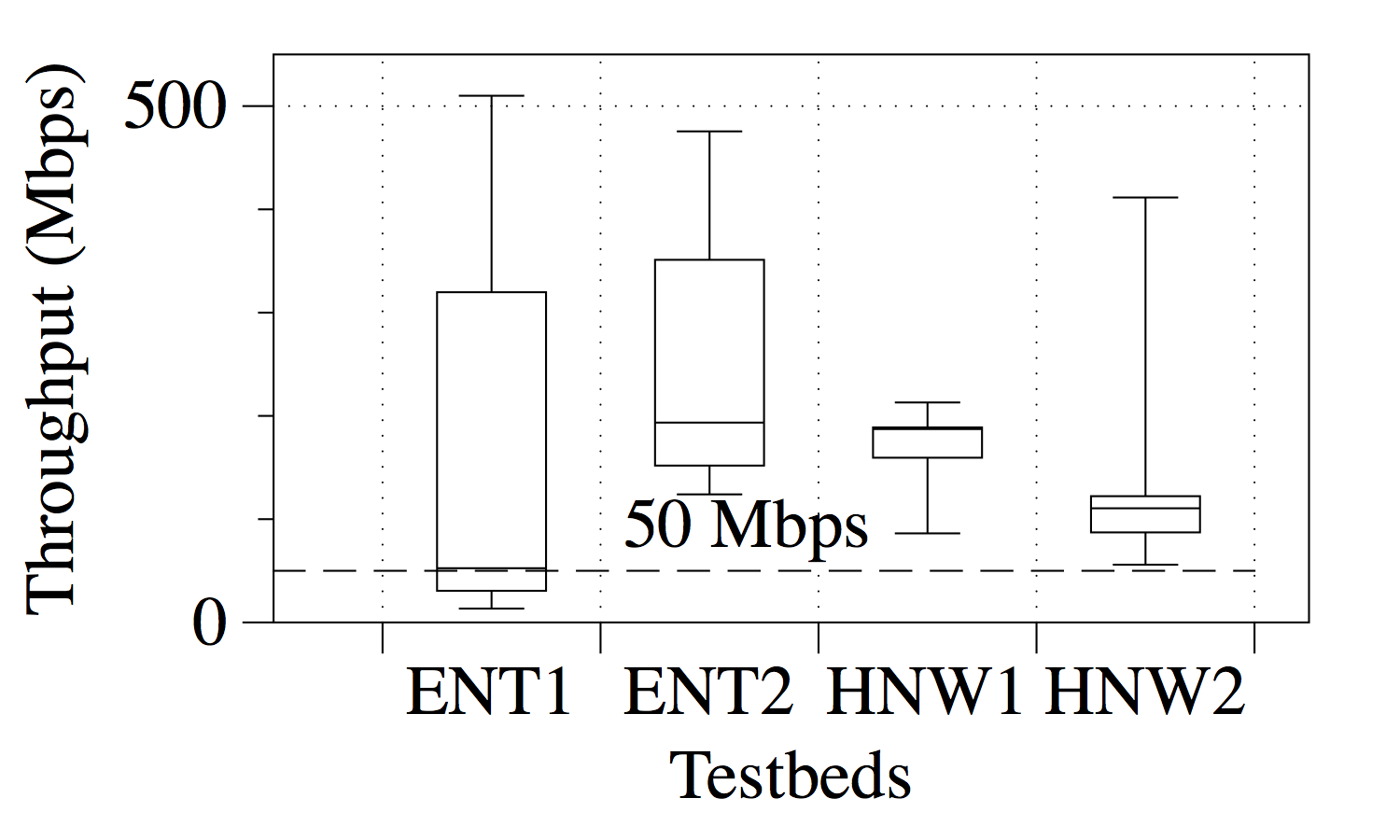
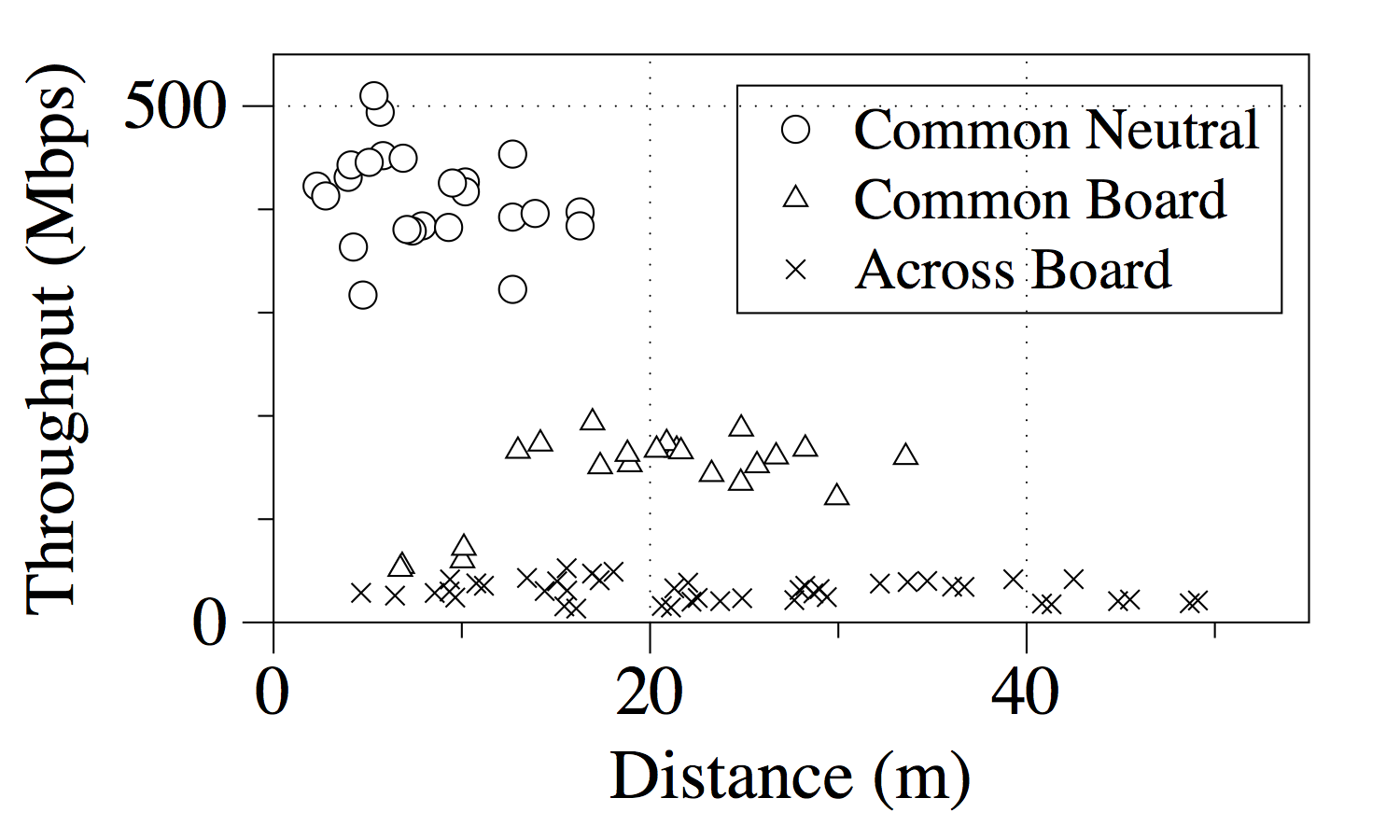
Today, power line communications (PLC) based WiFi extenders are emerging in the market. By simply plugging an extender to a power outlet, a user can create a second access point which connects to a master AP/router using the power line infrastructure. The underlying belief is that this can enhance the throughput that a user can achieve at certain locations (closer to the extender) and potentially increase wireless capacity. In this paper, we conduct an in-depth measurement study to first see if this belief always holds true, and if it does, the extent to which the end-to-end throughput improves. Our measurement study covers both homes and enterprise settings, as well as single and multi-user (or multi-device) settings. Surprisingly, we find that in 46% of cases in an office environment, using a PLC extender does not result in an increase in throughput, even when a single client accesses the network and is located close to the extender. This is because unlike in the case of an Ethernet backhaul, the PLC backhaul could consist of poor quality links (49% of the time in an office environment). We also find that the further away the extender is from the master router, the more likely this possibility becomes. We find that sharing of the PLC backhaul across devices could also be undesirable in some cases, and certain users should connect directly to the master AP in order to improve total throughput. Our study sheds light on when these effects manifest themselves, and discusses challenges that will need to be overcome if PLC extenders can be effectively used to enhance wireless capacity.
In this project, we conduct an in-depth measurement study to see if the better quality wireless links translate to real throughput gains with PLC extenders. We also seek to quantify these gains (or losses if they occur) and determine the root causes for these. We perform this measurement study despite the common belief that these extenders are beneficial because of two motivating observations. First, the throughputs achievable on power lines are not deterministic; in other words, the throughputs achievable between the master router and different PLC extenders could be different. Second, if multiple client devices (or users) share the PLC backhaul, there could be contention on the backhaul that results in degraded performance. In brief, the key take aways of our measurement study are as follows.
Measurement Setup: Our equipment consists of a commercial WiFi router (Netgear Nighthawk AC1900), six commercial PLC extenders (TP-Link TL-WPA8630), and four clients (Lenovo Ideapad 300S). We perform measurements in four environments: a 10-room office space (ENT1), a large single-room laboratory (ENT2), a two-story home (HNW1), and a one-story apartment (HNW2). Clients are placed roughly uniformly in each environment, and by default choose a WiFi access point with the highest RSSI. We perform 10-minute iperf3 tests between the PLC extenders or clients and the master router, to measure the total achievable (saturation) throughputs between each pair. We also experiment with web browsing and video streaming applications to showcase application performance. On all four testbeds, we measure the pairwise throughput between unoccupied power outlets.


Understanding Influence of Power Line Configurations: We find that in all but the ENT1 testbed, the achievable saturation throughputs are higher than the threshold. We then look at the power circuit diagrams of ENT1 to determine when the saturation throughputs are lower than the threshold. From the right figure above, we find that if two power outlets connect to circuits that use a common neutral line, they have very high throughput (around 400 Mbps). If two power outlets connect to the circuits that belong to the same distribution board but different neutral lines, the throughput between them drops to less than 200 Mbps. Most importantly, if two power outlets connect to circuits that belong to different distribution boards, the throughput becomes lower than 50 Mbps, causing the PLC connection to become a bottleneck. The reason for the above is that in order to go between the distribution boards, the connection has to traverse an electrical transformer which attenuates a range of frequencies used by power line communications.
From the same figure, our studies reveal that the distance between two power outlets is relatively small (they are in close proxmity), it is still possible that the PLC throughput between them is very low. However, the larger the distance between two power outlets, the more likely it is that they can only sustain a lower PLC throughput between them.
Throughput Gains from PLC Extenders: To delve further into the office environment (ENT1) where PLC can be most helpful, we analyze the reasons for the throughput gains. Specifically we ask the following questions. Can PLC extenders help even when the PLC backhaul quality is poor? Are there cases where good PLC backhaul is not helpful, because the WiFi-only throughput is very high? For each client location, in addition to the end-to-end throughput, we measure the throughput of the PLC backhaul, and classify it as good or bad. The below figure summarizes our results. In 34% of cases, we have the expected scenario where throughput gain results from a poor (direct) master WiFi and a good PLC backhaul connection. However, in 20% of cases, even a poor-quality PLC backhaul connection can help if the WiFi link to the master router is poor (due to at least one obstructing wall). We also see the opposite scenario in 10% of locations, where a good-quality PLC backhaul link does not help because the WiFi link to the master router is still very good (due to a clear line of sight).
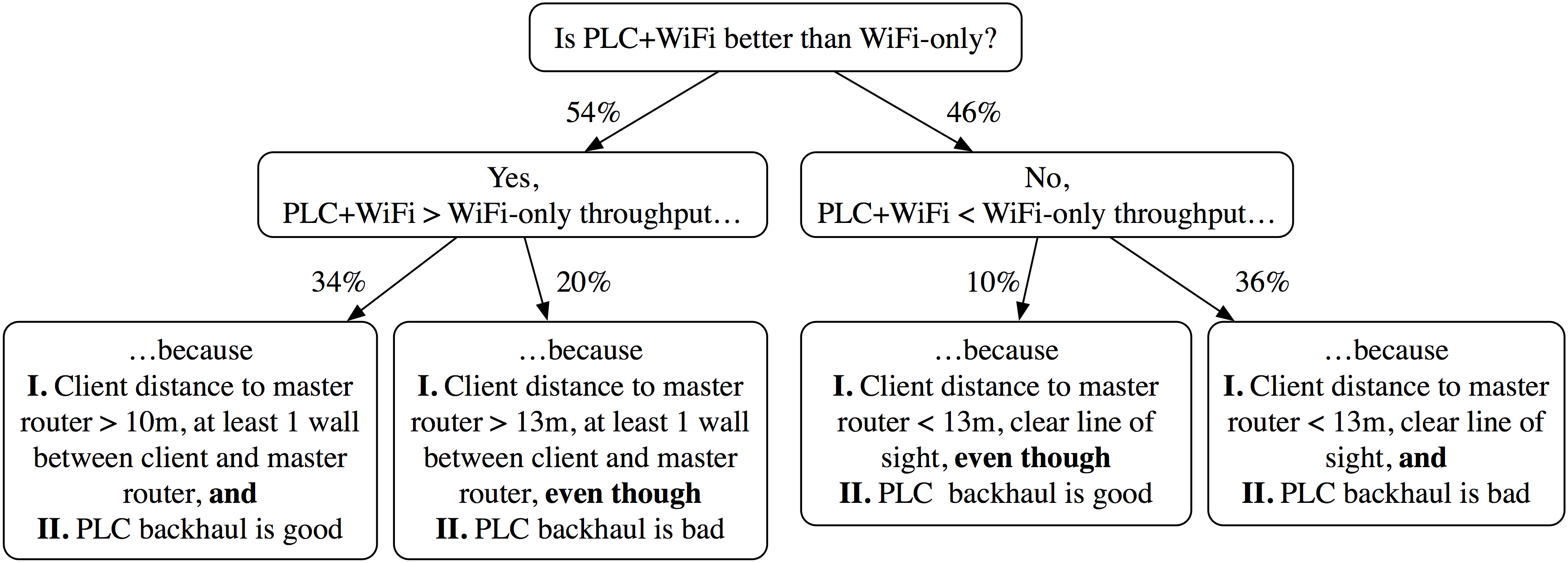
Throughput changes with distance from the master router: We first examine the impact of distance of the PLC extender from the master router. If the extender is close to the router, we expect the throughput gains for the client to be minimal, because the master router's WiFi signal will be already strong. However, as the distance between the extender and the router increases, the master router's WiFi quality will degrade, and the PLC extenders should help, especially when the PLC backhaul is good. The left figure below indicates that even a poor-quality PLC backhaul yields throughput gains if (and only if) the extender is quite far (18 m or further) from the router. When the PLC backhaul is good however, we see a throughput gain when the extender is as close as 12.7 m away from the router (the right figure).
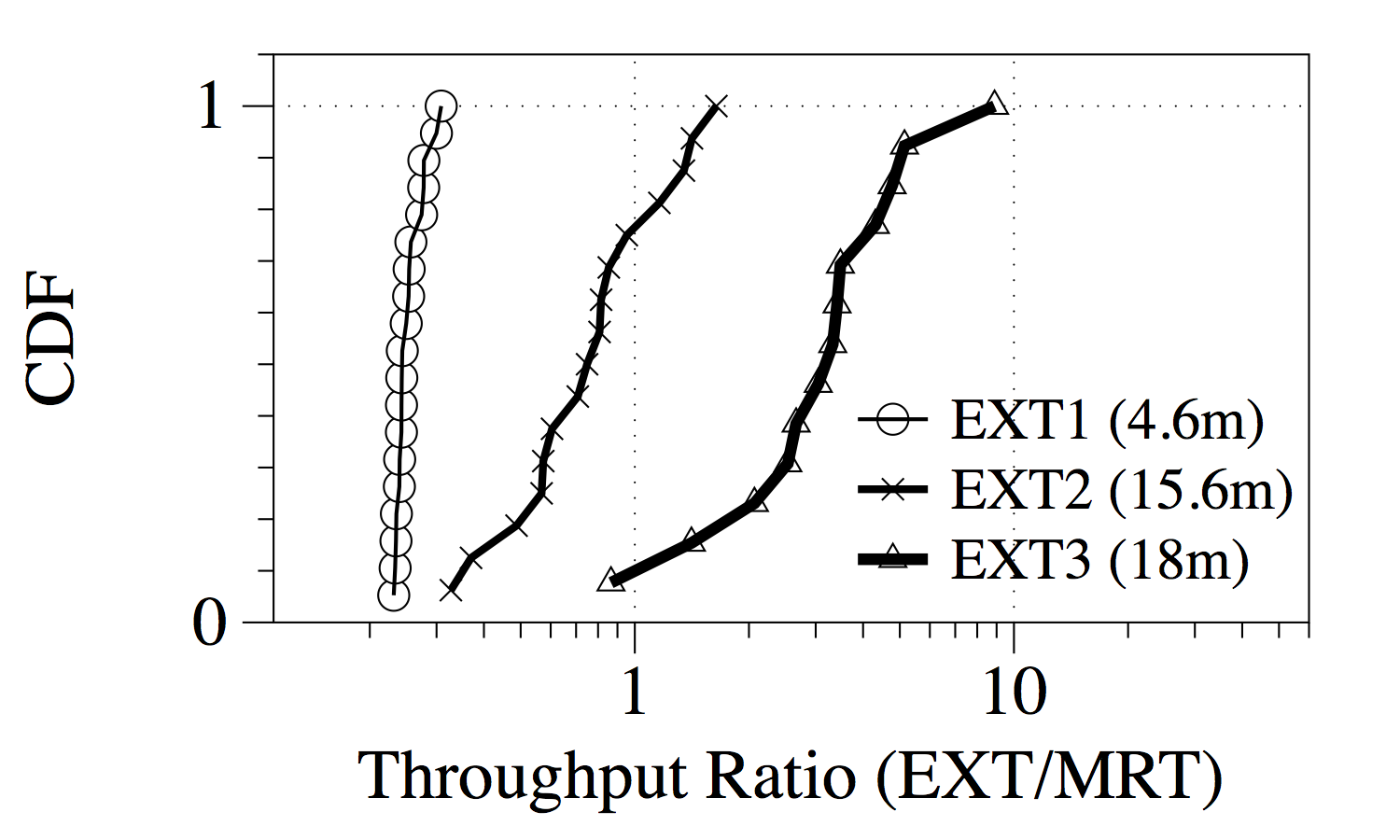
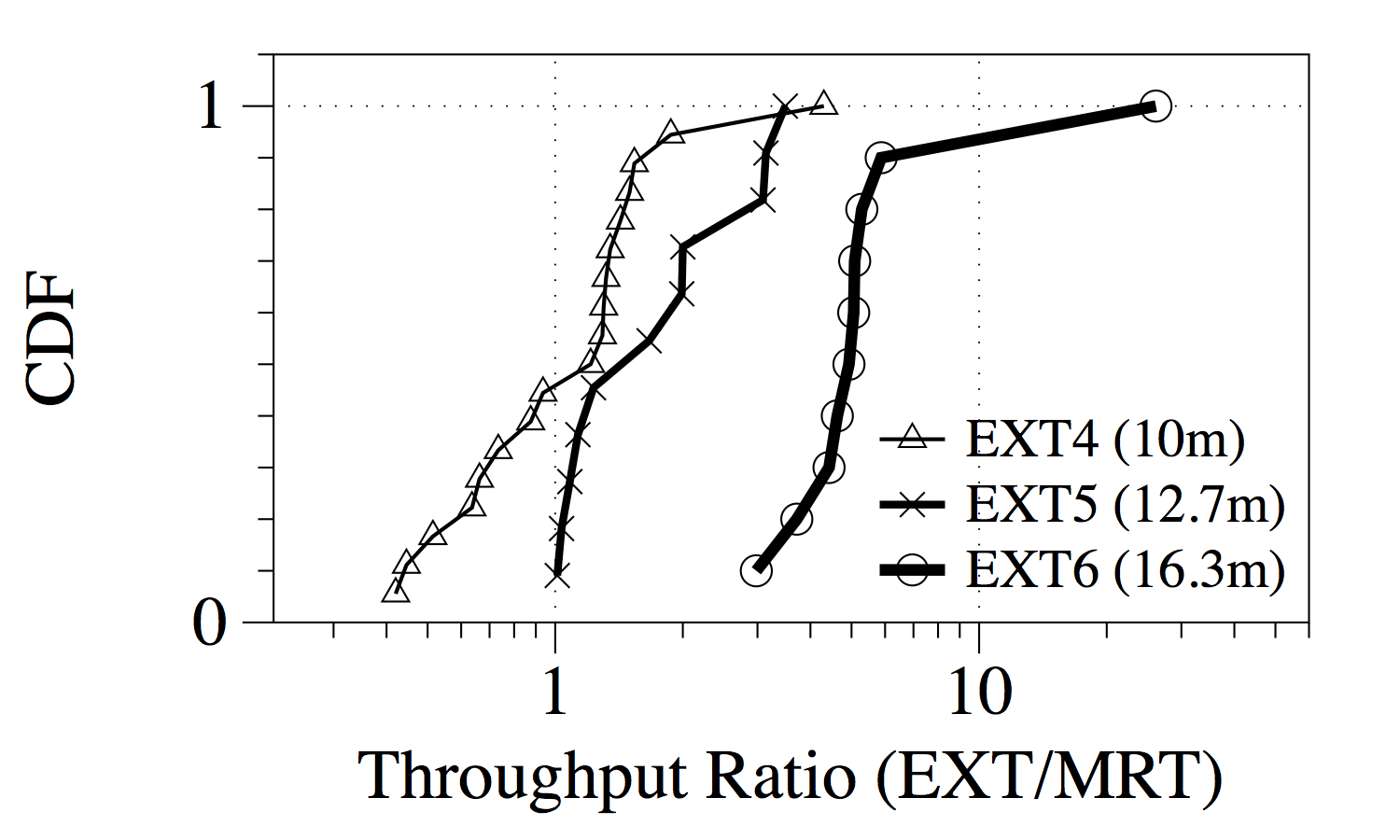
Sharing PLC Backhaul: In the single-user scenario, we found that in 54\% of locations in the office environment (ENT1), a client can benefit by connecting to a PLC extender. However, in the multi-user scenario, the client's benefit from connecting to a PLC extender may be reduced due to increased PLC backhaul contention. Should clients close to the master router connect to it, relieving contention on the PLC backhaul for the remaining clients on PLC? If this causes a reduction in the switching client's throughput, does the resulting gain of the other clients provide a net benefit? To investigate this, we consider four clients in the office environment (ENT1) which can potentially associate with four PLC extenders, as shown in the left figure below. In the single-user case, a client far away from the master router (client D) received 12 Mbps when connecting to a PLC extender, but in the multi-user case when three other clients also connect via PLC extenders (clients A,B,C), its throughput drops to 2.98 Mbps. What if the client closest to the master router (client A) switches? If that case, we see that all clients increase their throughputs, as shown in the right figure. However, if a client slightly further away from the master router switches (client B), it slightly sacrifices its own throughput to benefit the other clients. If switching one client helps, does switching both clients help? We find that switching both clients (A,B) to the master router lowers total throughput due to increased contention on the master router's WiFi. This suggests that when multiple clients are present, a few clients close to the master router should connect to it in order to reduce PLC backhaul contention and improve throughput for distant users; however, switching too many clients causes contention between the master router's clients and lowers total throughput. We envision that an iterative approach where clients closest to the master router are sequentially switched could help effectively identify the optimal set that should be switched.
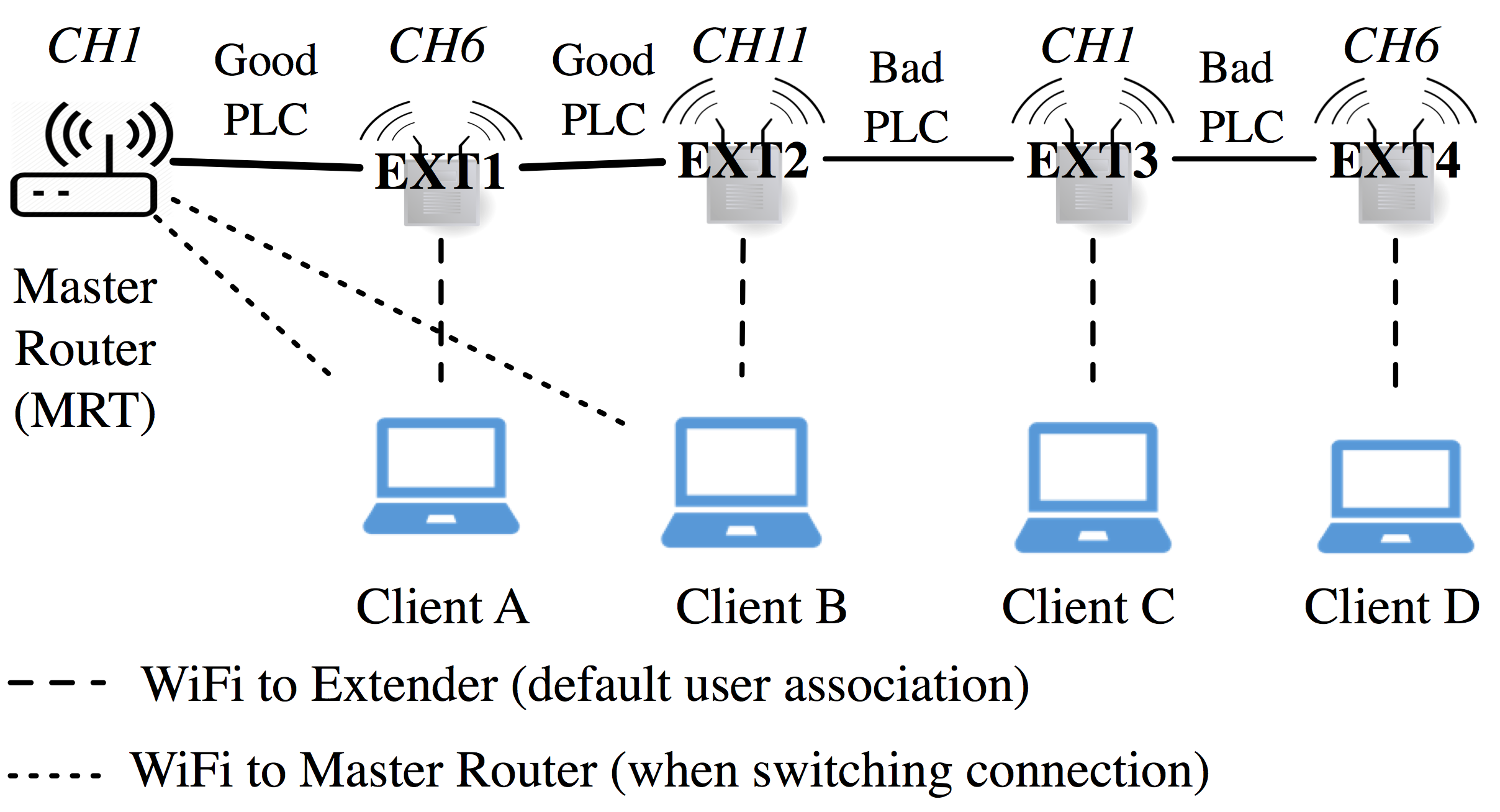
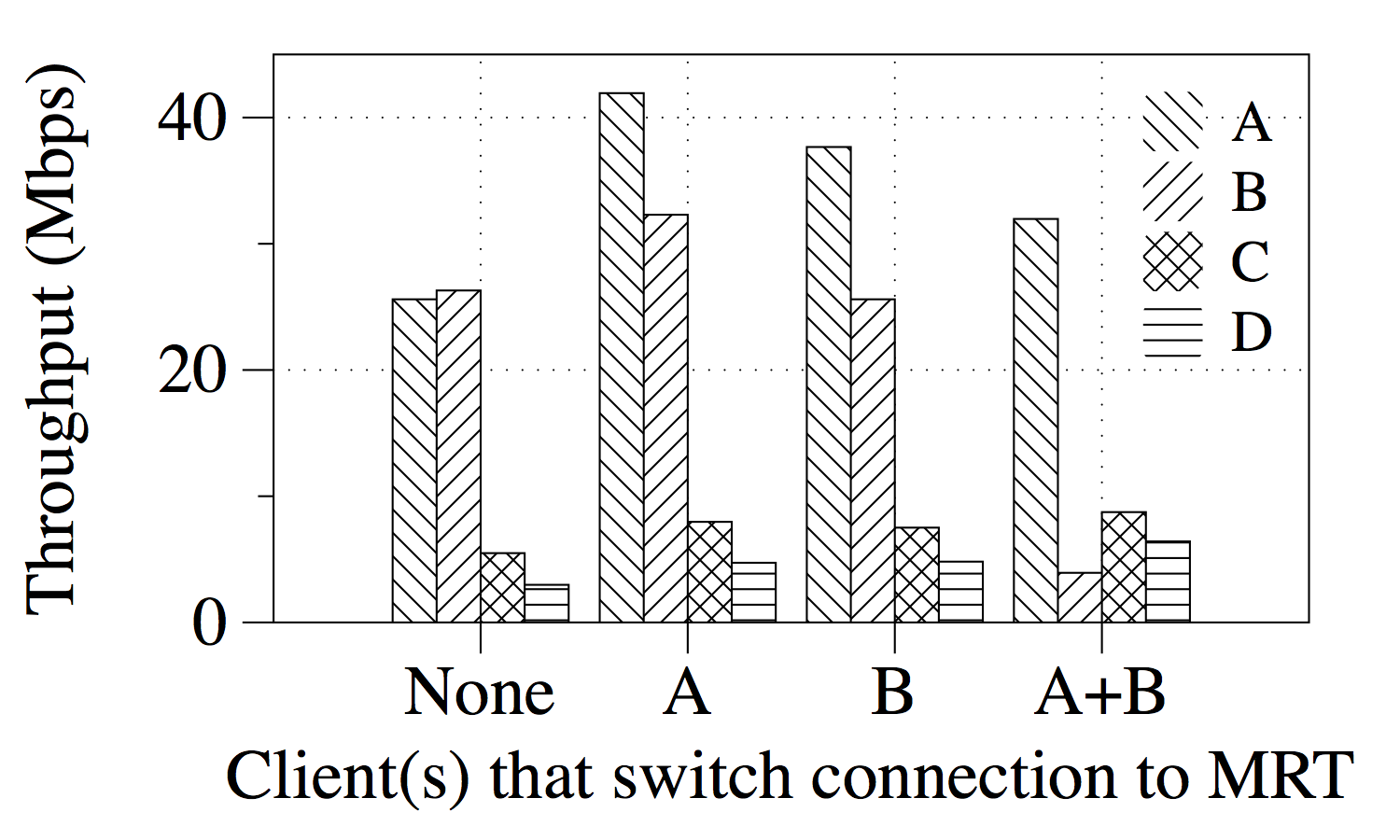
We further examine the medium sharing on the PLC backhaul in isolation (i.e., without WiFi). We find that the the default operation of the PLC extenders adheres to time-fair medium sharing, with each extender receiving throughput commensurate with its PLC link quality (rate). Specifically, we connect one laptop to a Netgear R7000-100NAR Nighthawk master router via Ethernet. The master router interfaces with the PLC backhaul via a PLC central unit. Four PLC extenders are plugged into different power outlets in our lab, with one client laptop connected to each extender through Ethernet (note that the Ethernet capacity is very high at 1 Gbps so any throughput degradation is caused by the PLC). A laptop connected to the master router serves as an iperf3 server and transmits saturated downlink TCP traffic to the four client laptops. We experimented with four PLC links of varying link qualities (rates), with the maximum achievable throughput of each PLC extender in isolation ranging from 60-160 Mbps, as shown in the left figure below. To see the impact of medium sharing on PLC backhaul throughput, we activated multiple extenders simultaneously, and plot the results in the right figure below. With two extenders actively receiving iperf3 traffic, we observe that each PLC link now delivers half of what it could in isolation (with higher throughput for the extender with better rate); with three extenders active, each PLC link delivered one third of what it could in isolation, and with four extenders active, each PLC link delivered one quarter of what it could in isolation. This suggests that the PLC backhaul is time-shared, and other researchers have made similar observations. We note that the time-fair-like behavior we observed is the default behavior of the off-the-shelf TP-Link PLC equipment that are popular with consumers, and we have observed similar default behavior with other brands of PLC equipment as well.
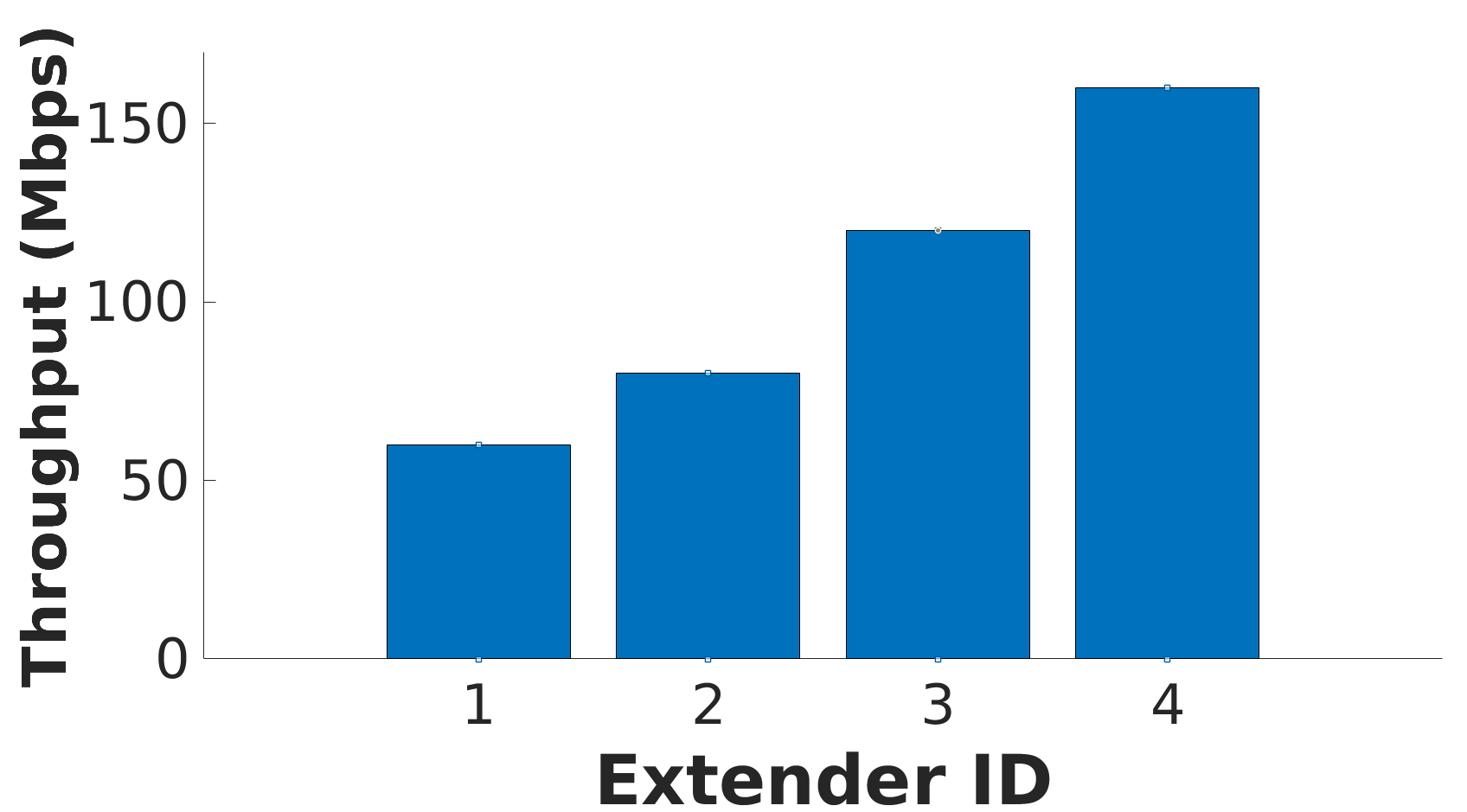
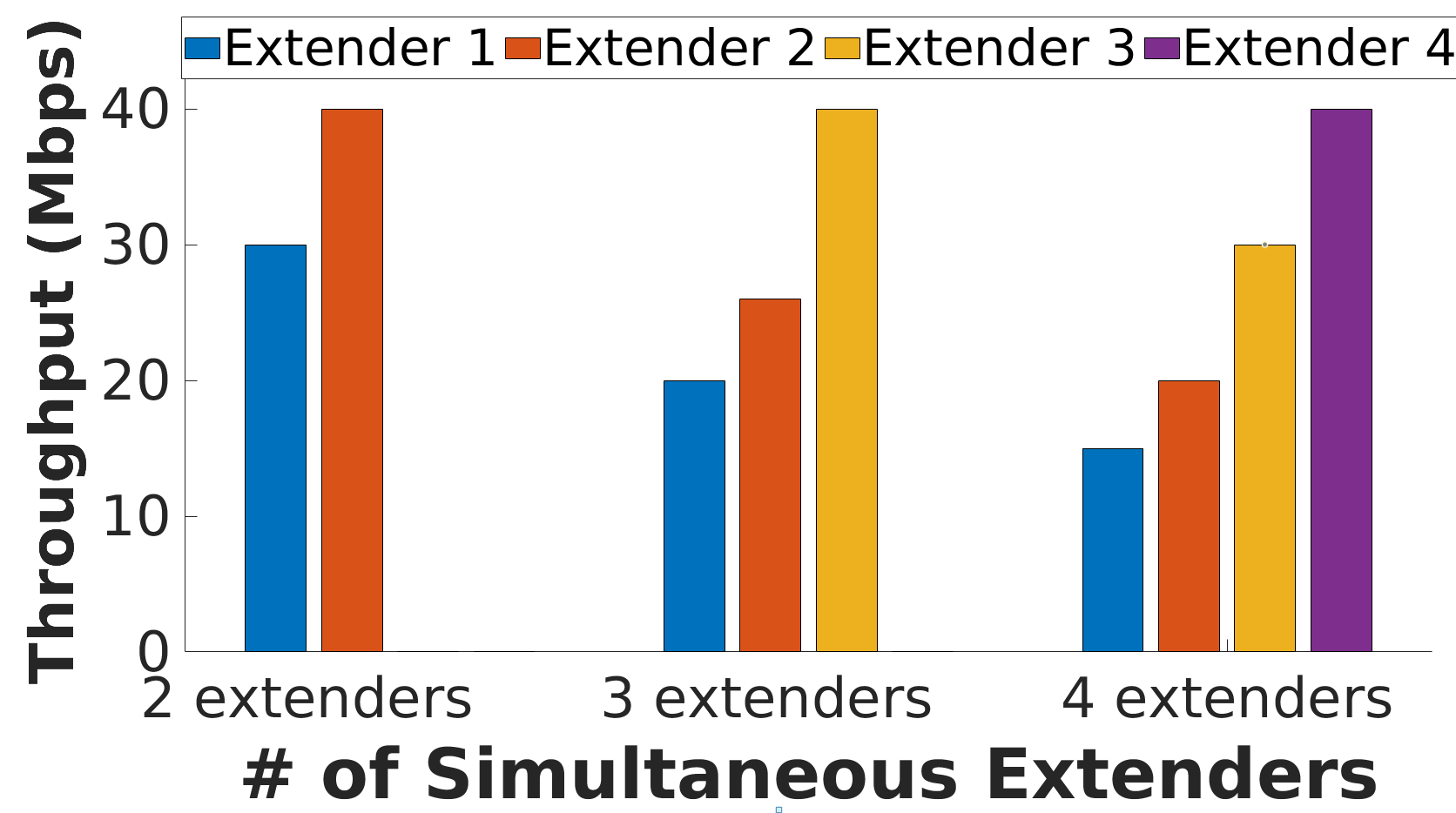
WiFi with PLC backhaul sharing: As discussed above, with our experimental apparatus, the WiFi and PLC parts seem to adhere to different medium sharing schemes. Next, we consider two types of PLC-WiFi concatenated links: (a) a concatenated link wherein the WiFi link segment is of better quality (yields higher throughputs) than the PLC link segment, and (b) a concatenated link where the PLC link segment is of better quality than the WiFi link segment. The total throughput of a group of users connected to the same extender follows the WiFi-only throughput-fair sharing behavior discussed before and can be expressed as:

where T_WiFi_j is the aggregate WiFi throughput at extender j, i is the user index, Nj is the set of users connected to extender j, and rij is the WiFi rate between User i and extender j. Note here that the WiFi throughput is taken to be the sum throughput achieved across all users connected to the same extender (similar to the PLC link throughput, which is the total throughput across the clients sharing that link). The PLC link segment throughput adheres to the time-fair sharing discussed above and can be expressed as:

where T_PLC_j is the aggregate PLC throughput at extender j, cj is the PLC rate and A is the number of active extenders. Given the above, the achievable throughput that an extender (say j) can obtain is the minimum of the throughputs on the two concatenated link segments, i.e., it is given by min(T_WiFi_j, T_PLC_j). Furthermore, in some cases, a PLC link segment can yield a higher throughput than its aggregate WiFi links, while in other cases it might not. If the WiFi link segment that is part of a concatenated link yields lower throughput than what the associated PLC link can support (i.e., T_WiFi_j less than T_PLC_j), then that PLC link will have unused capacity. This leftover capacity (time share) can be then exploited by other extenders which might have a higher demand, because their connected WiFi users have good channel conditions and thus demand more traffic than their extender’s time-fair share of the PLC medium could have supported.
In the previous sections, we studied saturation throughput of PLC+WiFi networks. In this section, we wish to understand how PLC extenders impact application performance. To do this, we conduct experiments with two popular applications viz., video streaming and web browsing.
Video Streaming: Dynamic adaptive streaming over HTTP (DASH) is one of the most common video streaming protocols in use today. However, previous studies have shown that multiple clients sharing a bottleneck link unfairly choose video bitrates that allow some clients to monopolize the link, and also experience a high degree of instability. In our study, we find that not only does this issue manifest over PLC links, but in addition the magnitude of the video bitrate and frequency of bitrate switches depends on the quality of the PLC backhaul. In our setup, we stream an 8-minute 1080p DASH video encoded at four different bitrates (1.6, 2.4 4.8, 8 Mbps) to two clients. To see the impact of the PLC backhaul, one client is associated with a good PLC extender, and the other with a bad PLC extender.
The video bitrates are plotted in the left figure below across ten trials. In the multi-user case, both clients are negatively impacted by PLC contention, decreasing the average video bitrate and increasing the average number of switches compared to the single-user case. Moreover, both both metrics have higher variance. In particular, the good-PLC client suffers a higher variance despite enjoying a higher video bitrate on average, than the bad-PLC client. This is because it occasionally suffers from very low bitrates due to contention on the PLC backhaul. Similarly, the good-PLC client enjoys a fewer number of bitrate switches on average but occasionally sees a large number of bitrate switches (not shown due to space limitations).
Web Browsing: How does good and bad PLC impact page load time? In contrast to video streaming applications, which suffer from reduced video bitrates when the PLC backhaul is poor, we find that web-browsing clients can still enjoy low page load times even when they are located far from the master router. To show this, we load the Top 100 Alexa websites on a client and record two metrics: (a) web response start (WRS), the latency between when the browser requests the page and when it receives the first web object, (b) web load complete (WLC), the latency between when the browser requests the page and when it receives the last web object.
We evaluate this in the office environment (ENT1), and place the client close to each extender to focus on impact due to PLC backhaul quality. In the right figure below, we plot the WRS and WLC as a function of the client's distance from the master router. If the client connects to the PLC extenders we can see that no matter the client's distance from the master router, the WRS and WLC are nearly constant. However, if the client connects to the master router, it experiences relatively high WLC after 29 m. Notably, at the two user locations that are most distant from the master router (40 and 48m), the client loses WiFi connectivity to the master router and can only load the webpage via the PLC extenders. This suggests that for web browsing, PLC extenders can very beneficial even if the quality of the PLC backhaul link is poor.
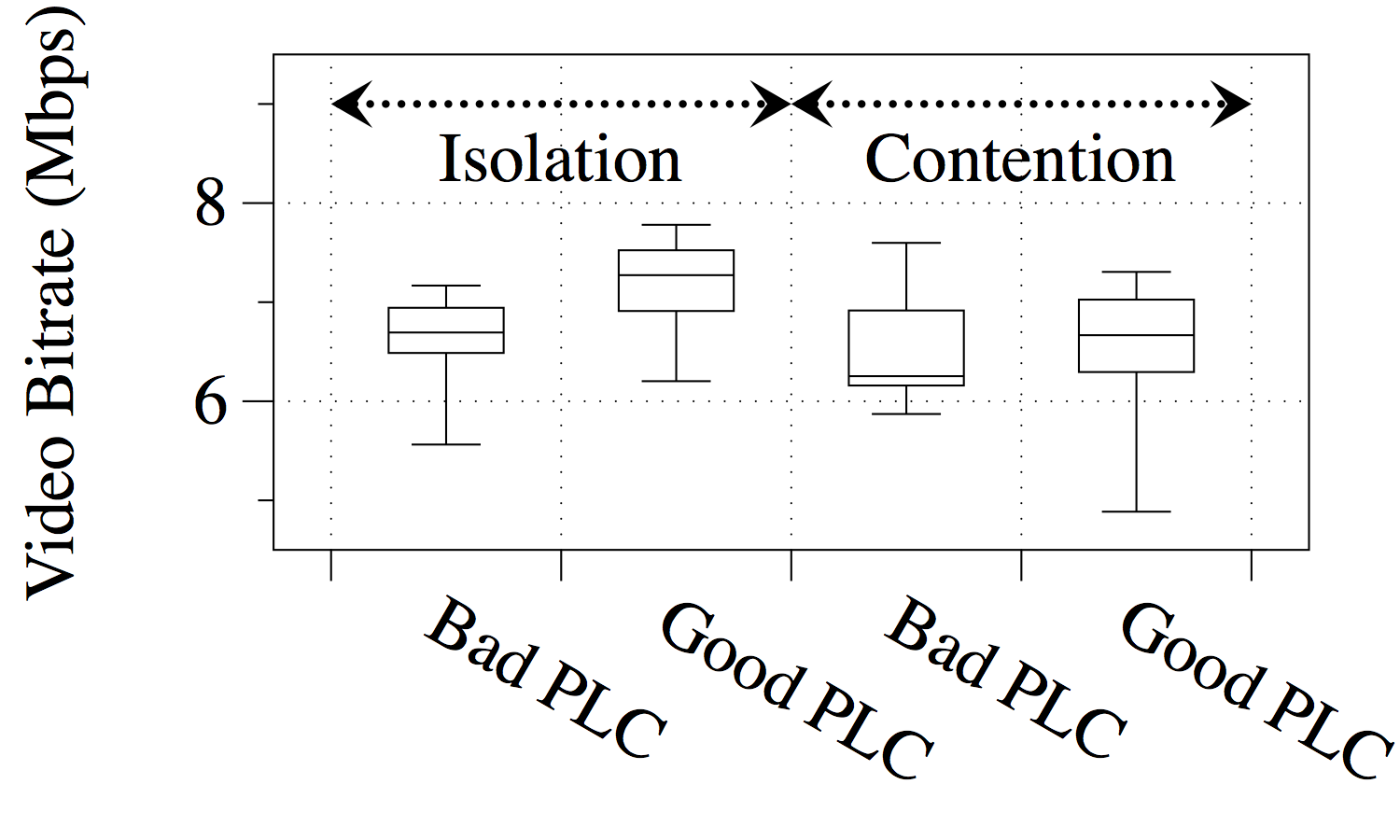
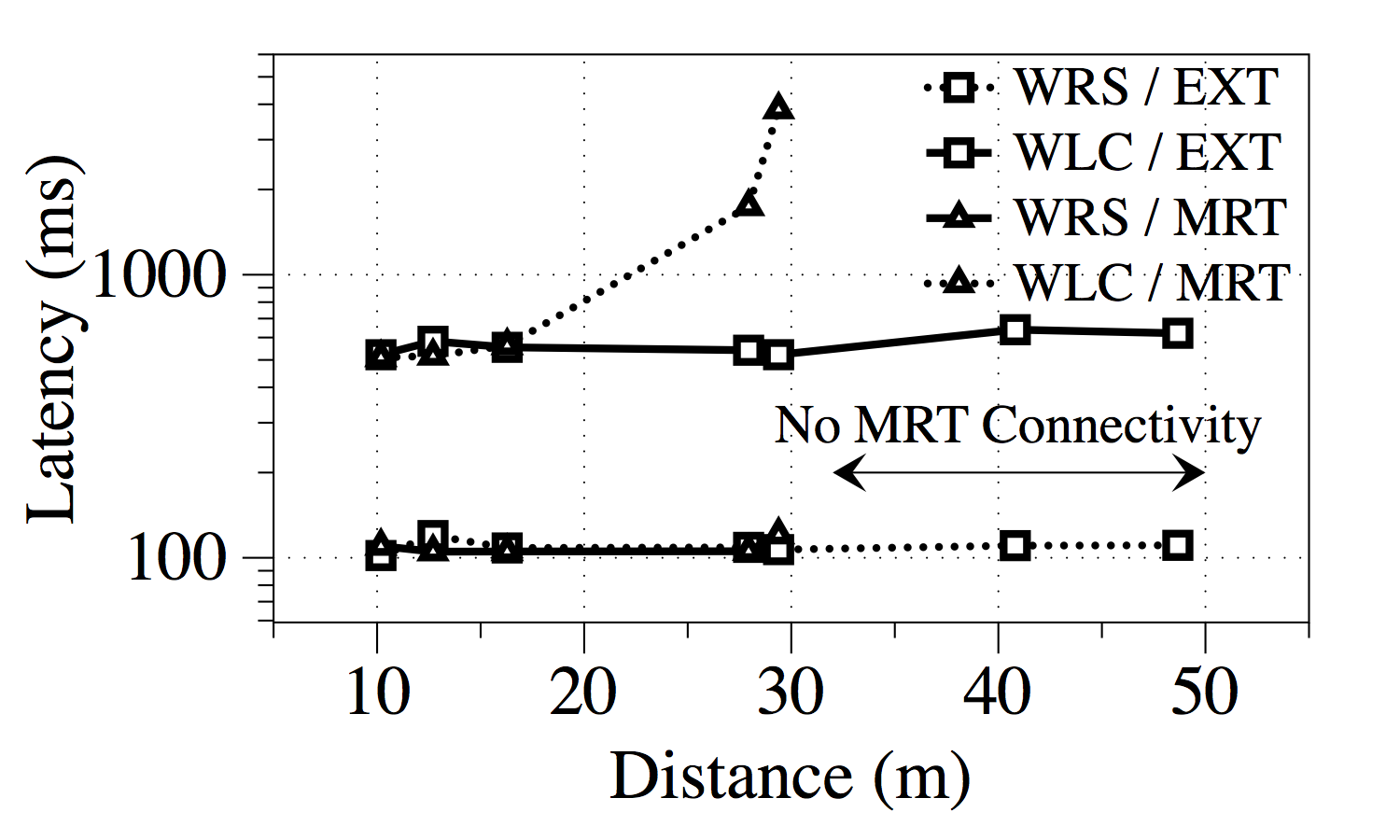
Power line communications are attractive for providing backhaul Internet connectivity in settings without an in-built network infrastructure, especially in third world countries. Several retail segments such as healthcare, industrial automation and warehousing, are increasingly relying on Internet connectivity. Unfortunately, the topology of a PLC network is often unknown since it is hidden behind walls and the connectivity is typically established without communications in mind; in fact, nodes that are geographically close are not necessarily direct neighbors. The network structure dictates which transmissions interfere with each other. While the 1901 MAC resolves this issue to some extent, it can lead to poor throughput as well as unfairness in many cases. To drastically reduce the ill effects of interference, an understanding of the network topology needs to be derived. In addition, the quality of the PLC channel is time varying. The impedance loads on the PLC lines vary as electrical devices that are plugged in, and are turned ON or OFF. This causes the throughputs on certain links to either degrade or improve, thereby causing dynamics in the network topology.
BOLT orchestrates an appropriately chosen set of concurrent flows within a single PLC network (at the granularity of time epochs) to enable high throughput. It overcomes the negative effects that arise with 1901 based MAC protocols during periods of high contention (as discussed earlier), by controlling the flows that are simultaneously active. The quasi- stationary nature of the PLC channel allows BOLT to adopt a learning approach to accurately predict the throughput due to interactions between pairs1 of contending flows with a small set of training measurements. It then efficiently schedules multiple application layer flows in real-time towards achieving very high spatial reuse. BOLT is primarily implemented at a central coordinator (CC), which is essentially one of the PLC nodes. BOLT’s operations consist of the following (continuously executing) phases.
WOLT solves the problem of assigning users to the appropriate PLC-WiFi extenders to increase the aggregate network throughput in an enterprise setting, where one may expect a relatively large number of power outlets. WOLT accounts for both the qualities of the two concatenated links viz., the PLC and WiFi links. It hinges on estimating the best capacity offered by the PLC links, and accounting for these while assigning users. It incorporates a polynomial-time algorithm that assigns only a subset of the users to maximize the aggregate throughput on the PLC links, and then assigns the remaining users such that the degradation in the aggregate throughput is minimized. WOLT is evaluated through simulations and real testbed experiments with commodity PLCWiFi extenders, and improves aggregate throughput by more than 2.5x compared to a greedy user association baseline.